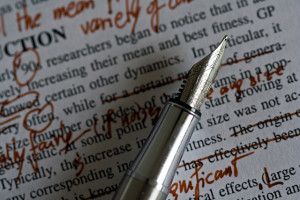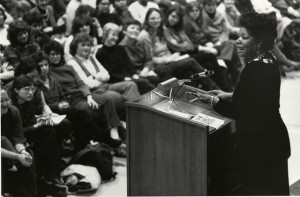
(Courtesy of Nic McPhee; Creative Commons)
My first drafts are ugly.
They’re usually scribbled in a cheap, spiral notebook or on Post-Its. Once, I wrote an entire short story on a roll of paper towel because the dialogue just poured out of me. Well, that and I was too lazy to get my cheap, spiral notebook. (Side note: I reserve expensive, cutesy journals for big picture thinking, like taking over the world and notes about making The New York Times Best Sellers list, you know, normal stuff.)
I used to hate my first drafts because my prose wasn’t coherent, organized, smart and flowery as if Maya Angelou spent the afternoon whispering “Phenomenal Woman” in my ear.
Plus, the words never came out fast enough. It’s like a slow brain dump of notes, sketches and incomplete sentences if I’m lucky. Sometimes random words are scattered on the page reminding me about word counts, goals, moods and notes for the reader. The result always resembles evidence for a murder case on an episode of Law & Order.
I assumed, like most fans of Mother Maya’s gift, that she was a “natural writer.”
She wasn’t. The woman who blessed us with Just Give Me a Cool Drink of Water Before I Diiie kept a hotel room in every city where she lived so she could have a workspace for her art, made writing look easy. Sound easy. Read easy.
Writing is never easy.
When George Plimpton interviewed her for The Paris Review, she revealed that it took her forever to make her books sing. The Pulitzer Prize nominee “worked” on the language. If she had nine pages of copy, two (or three) were usually good.
I believe that means that we can stop being so hard on ourselves as writers. I must accept my ugly drafts as part of my process, and you should too. It’s also the way to becoming a more polished writer.

As you sit down at your desk (or a bed with a bottle of sherry, like Mother Maya used to do), consider this as you compose your first draft.
Sketch an outline: Skip the Roman numerals Ms. Simon taught you in elementary school and the stiff formula Professor Ogiri swore by in college. Go for a loose road map of where you’d like your short story to go. Just realize that all this beautiful planning is subject to change.
Don’t worry about it making sense: Stop forcing yourself to start with a powerful opening sentence and make the essay flow in order. It’ll come when you least expect it, like in your morning shower or at the dinner table. (Keep a notebook or smart phone ready to record notes or voice memos.) Just jump in at the middle and go.
Brainstorm and put everything on the page: Get it out of your system—556, 838 or 2,045 words. Read, revise and cut the guest blog’s required word count in the second or third draft.
Resist the urge to write and edit at the same time: It’s challenging to finish a longer piece of writing—like your memoir—this way. Writing and editing as you go isn’t a shortcut. To me, it makes crossing the finish line more difficult, especially when a story has tons of moving parts. Complete a horrible, ugly first draft (mine will keep you company) and then go back to fix holes, timelines, descriptions and voice.
The best writing is deceptive, or as Nathaniel Hawthorne (author of The Scarlet Letter) said: “Easy reading is damn hard writing.”
What does your first draft look like?
